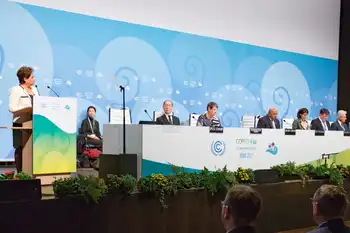Cost makes green power a tough sell
VIRGINIA - Michael PolskyÂ’s wind farm company was doing so well in 2008 that banks were happy to lend millions for his effort to light up America with clean electricity.
But two years later, Mr. Polsky has a product he is hard-pressed to sell.
His company, Invenergy, had a contract to sell power to a utility in Virginia, but state regulators rejected the deal, citing the recession and the lower prices of natural gas and other fossil fuels.
“The ratepayers of Virginia must be protected from costs for renewable energy that are unreasonably high,” the regulators said. Wind power would have increased the monthly bill of a typical residential customer by 0.2 percent.
Even as many politicians, environmentalists and consumers want renewable energy and reduced dependence on fossil fuels, a growing number of projects are being canceled or delayed because governments are unwilling to add even small amounts to consumersÂ’ electricity bills.
Deals to buy renewable power have been scuttled or slowed in states including Florida, Idaho and Kentucky as well as Virginia. By the end of the third quarter, year-to-date installations of new wind power dropped 72 percent from 2009 levels, according to the American Wind Energy Association, a trade group.
Mr. Polsky calls the focus on short-term costs shortsighted.
“They have to look for the ratepayers’ long-term interest,” he said, “not just the bills this year.”
Electricity generated from wind or sun still generally costs more — and sometimes a lot more — than the power squeezed from coal or natural gas. Prices for fossil fuels have dropped in part because the recession has reduced demand. In the case of natural gas, newer drilling techniques have opened the possibility of vast new supplies for years to come.
The gap in price can pit regulators, who see their job as protecting consumers from unreasonable rates, against renewable energy developers and utility companies, many of which are willing to pay higher prices now to ensure a broader energy portfolio in the future.
In April, for example, the state public utilities commission in Rhode Island rejected a power-purchase deal for an offshore wind project that would have cost 24.4 cents a kilowatt-hour. The utility now pays about 9.5 cents a kilowatt hour for electricity from fossil fuels.
The state legislature responded by passing a bill allowing the regulators to consider factors other than price. The commission then approved an agreement to buy electricity from a smaller wind farm, although that decision is being challenged in the courts.
Similarly, in Kentucky this year, the public service commission voted down a contract for a local utility, Kentucky Power, to buy electricity from NextEra Energy Resources in Illinois.
According to the commission, Kentucky Power argued that the contract would position the utility “to better meet growing environmental requirements and impending government portfolio mandates for renewable energy” and that it would benefit customers.
But Kentucky’s attorney general, Jack Conway, joined by business and industrial electricity users, opposed the deal, contending that it would have increased a typical residential customer’s rates by about 0.7 percent and was “a discretionary expense” that the utility’s customers could ill afford.
Commissioner James W. Gardner, the lone dissenting commissioner, protested that “there is a necessity for this power” and said that “there are great pressures nationally and in Kentucky to increase renewables.”
Companies that make solar cells and wind machines argue that a national energy policy is needed to guarantee them a market that will allow their industry to develop. Clean power will be an important industry globally for years, they say, and if the United States does not subsidize renewable energy now, it risks falling far behind other countries.
They point to China, which is rapidly increasing the amount of electricity it generates from renewable sources. In its most recent quarterly assessment of the renewable energy sector, the accounting and consulting firm Ernst & Young identified China as the most attractive market for investment in renewable energy.
In part, the analysis suggested, this reflected the failure of American lawmakers to pass a national renewable energy standard and the looming expiration of a Treasury program that allowed renewable developers to receive cash grants in lieu of tax credits.
In Europe, many national governments have guaranteed prices for energy from sun or wind. As a result, renewable advocates say, many countries are on track to meet the European UnionÂ’s goal of 20 percent of energy from renewable sources by 2020.
The United States has relied on a combination of state renewable energy mandates and federal tax credits to encourage greater reliance on energy from renewable sources. Legislation that would have set a price on carbon-dioxide emissions and included a standard for increasing the share of clean energy in the nationÂ’s electricity portfolio failed in Congress this year.
“Our investors tell us they’re nervous about all the uncertainty,” said John Cusack, the president of Gifford Park Associates, a sustainability management and investment consulting firm in Eastchester, N.Y. “They don’t know what’s going to happen.”
To be sure, a lot of renewable power development is still going forward. The American Wind Energy Association estimates that wind farms capable of producing 6,300 megawatts of wind power are under construction, and that a busy second half of 2010 would leave installations about 50 percent behind last year. Solar power is becoming less expensive, and its use is expanding rapidly. But it still accounts for less than 1 percent of the nationÂ’s electricity needs, providing enough to serve about 350,000 homes.
Renewable energy supporters argue that higher fossil fuel prices will eventually make renewable energy more competitive — and at times over the last two decades, when the price for natural gas has spiked, wind power in particular has been a relative bargain. Advocates also argue that while the costs might be higher now, as the technology matures and supply chains and manufacturing bases take root, clean sources of power will become more attractive.
Fold in the higher costs of extracting and burning fossil fuels on human health, the climate and the environment, many advocates argue, and renewable technologies like wind power are already cheaper.
“One of the problems in the United States is that we haven’t been willing to confront the tough questions,” said Paul Gipe, who sits on the steering committee of the Alliance for Renewable Energy, a group advocating energy policy reform.
“We have to ask ourselves, ‘Do we really want renewables?’” he said. “And if the answer to that is yes, then we’re going to have to pay for them.”
Related News

California avoids widespread rolling blackouts as heat strains power grid
LOS ANGELES - California has avoided ordering rolling blackouts after electricity demand reached a record-high Tuesday night from excessive heat across the state.
The California Independent System Operator, which oversees the state’s electrical grid, imposed its highest level energy emergency on Tuesday, a step that comes before ordering rolling blackouts and allows the state to access emergency power sources.
The Office of Emergency Services also sent a text alert to residents requesting them to conserve power. The operator downgraded the Stage 3 alert around 8:00 p.m. PT on Tuesday and said that “consumer conservation played a big part in protecting electric grid…




